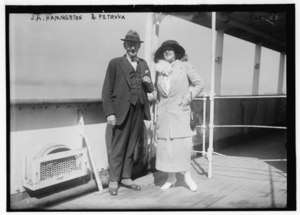John Alexander Hammerton
Sir John Alexander Hammerton (27 February 1871, in Alexandria, Scotland – 12 May 1949, in London) is described by the Dictionary of National Biography as "the most successful creator of large-scale works of reference that Britain has known".[1]

Collaboration with Arthur Mee
Hammerton's first posts in journalism included a period in Nottingham, where he first met his lifelong collaborator and friend, Arthur Mee. In 1905, Hammerton joined Alfred Harmsworth's Amalgamated Press. He and Mee produced the Harmsworth Self-Educator.
Work on encyclopedias
Hammerton contributed to the first edition of Mee's Children's Encyclopædia, which was a fortnightly series from 1908 till 1910 before being published in eight large volumes. Hammerton's contribution consisted of compiling articles on 'Famous Books' and 'Poetry'.
Hammerton's greatest achievement was Harmsworth's Universal Encyclopædia. It was published first as a fortnightly series from 1920 to 1922. The Encyclopaedia sold 12 million copies throughout the English-speaking world.
Works about the First World War
The Great War
From 1914 to 1919, Hammerton was joint editor with Herbert Wrigley Wilson of the periodical The Great War: The Standard History of the All-Europe Conflict, published by the Amalgamated Press.
The first volume of The Great War concentrated on justifying Britain's entry into World War I, and with encouraging the British people to sign up and fight. In its entirety, The Great War ran to 13 volumes.[2]
Popular History
In 1933, Hammerton's A Popular History of the Great War (in six volumes) was published. In his introduction to volume 1, Hammerton discusses the previous World War I series: 'Although it remains a storehouse of information for future students of the period, "The Great War", as that set of thirteen massive volumes was called, would now require to be largely re-written in light of later knowledge'.[2]
Hammerton described Popular History as "embodying the gist of post-war revelations and official documents".[2]
- Volume 1: The First Phase: 1914
- Volume 2: Extension of the Struggle: 1915
- Volume 3: The Allies at Bay: 1916
- Volume 4: A Year of Attrition: 1917
- Volume 5: The Year of Victory: 1918
- Volume 6: The Armistice and After
Popular History contains 3,840 pages of text, 100 maps and diagrams, and 800 photographs.[3]
Other works
Hammerton later edited a biography of J. M. Barrie and studies of Charles Dickens and Robert Louis Stevenson. He also wrote Other Things than War: Musings and Memories (1943), and an autobiography, Books and Myself (1944).
Mee died in 1943. in 1946, Hammerton wrote a biography of him entitled Child of Wonder.
List of works
- Peoples of All Nations (1922)
- Peoples Of All Nations: Their Life Today And Story Of Their Past (in 14 Volumes) (2007)
- Peoples of all nations: their life to-day and the story of their past, Volume 1 (1922)
- Peoples of All Nations : Their Life Today and Story of Their Past (Photojournalist Account and Commentary Early Twentieth Century Anthropology - origins circa 1920)
- Lands and Peoples of the World (1985)
- The World's Greatest Books (1910) with Mee.
References
- Hadaway, Bridget. "Oxford DNB article Hammerton, Sir John Alexander". Oxford Dictionary of National Biography (subscription required; free to holders of a UK library ticket). Oxford University Press. Retrieved 2009-11-15.
- Hammerton, Sir J. A., ed. (1933). A Popular History of the Great War. I: The First Phase: 1914. London: Amalgamated Press. p. 3.
- Hammerton, Sir J. A., ed. (1933). A Popular History of the Great War. I: The First Phase: 1914. London: Amalgamated Press. p. 4.
- Dictionary of National Biography.
- On his contributions to the Children's Encyclopædia, see The World of the Edwardian Child, as seen in Arthur Mee's Children's Encyclopædia, 1908-1910 by Michael Tracy (2008)
- Works by John Alexander Hammerton at Project Gutenberg
External links
![]()
- Oxford DNB entry (subscription required; free access for holders of a valid UK Library ticket)
- Works by John Alexander Hammerton at Project Gutenberg
- Works by or about John Alexander Hammerton at Internet Archive
- Sir John Alexander Hammerton at Library of Congress Authorities, with 66 catalogue records